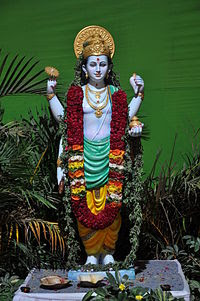Ayurveda - Crash Course
WTF is Ayurveda?
Ayurveda- Is a system of medicine with historial roots in the Indian subcontinent. Globalized and modernized practices derived from Ayurveda traditions are a type of alternative medicine.
Translation:
The name “Ayurveda” is derived from two words in Sanskrit, “ayuh” meaning “life” or “longevity” and “veda” meaning “science” or “sacred knowledge.” Ayurveda’s definition therefore roughly translates as “the science of longevity” or “the sacred knowledge of life.”
Origins:
The main classical Ayurveda texts begin with accounts of the transmission of medical knowledge from the Gods to sages, and then to human physicians. In Sushruta Samhita (Sushruta's Compendium), Sushruta wrote that Dhanvantari, Hindu god of Ayurveda, incarnated himself as a king of Varanasi and taught medicine to a group of physicians, including Sushruta. (Dhanvantari is pictured at the left here) Ayurveda is a tradition thought to be over five thousand years old.
How is this different than traditional medicine? How can this help me?
- Ayurveda encourages you to be an active participant in your own journey toward healing.
- In Ayurveda, every individual is unique and there is no diet or lifestyle routine that works for everyone.
- Prevention is key. Ayurveda focuses on providing specific advice and guidance on how to maintain physical and emotional health.
- Food and lifestyle routines are considered the most important medicine. If you come to an Ayurvedic doctor with a complaint, you are more likely to leave with a recipe than with a prescription for pills.
Some of the major ideas of Ayurveda:
So how does this work?
Ayurveda is based on the principles of three doshas. Doshas are the energies that make up every individual, which perform different physiological functions in the body.

The 3 Dosha types:
1. Pitta Dosha-
Pitta is known as the fire dosha and is responsible for digestion and transformation. Comprised of fire and water, pitta is the force responsible for breaking things down into digestible components. Individuals with a predominantly pitta constitution tend to have good digestion, an athletic build and a strong metabolism. They also tend to be sharp-witted and good decision makers. Pitta is strongest in the summer. When the pitta dosha is exacerbated, it can lead to problems like excess stomach acid, anger, bleeding disorders, and skin rashes. Pitta is exacerbated by eating hot and spicy food, excessive sour, salty, and fried foods, and holding onto aggression or anger. Pittas can maintain balance by following an appropriate diet and taking measures to “cool off” on a daily basis, by taking walks in nature, practicing restorative yoga, and avoiding unnecessary time pressures.
2. Kapha Dosha-
Kapha is comprised of earth and water and represents stability. The qualities of the kapha dosha are cold, immobile, moist, heavy, soft, and cloudy. Individuals with a predominantly kapha constitution tend to be steadfast, reliable and slow to anger. They have a strong constitution with lustrous skin and hair and a large build. When out of balance they can gain weight easily and are prone to swelling, congestion, and excess mucous. Kapha individuals can maintain balance by eating light foods and avoiding sweet and oily foods, which exacerbate kapha. Regular exercise also helps to balance kapha. Kaphas do best rising early in the morning and avoiding sleeping in late.
3. Vata Dosha-
Vata is the dosha of movement; it is comprised primarily of air and space. Vata is seated in the colon and governs the movement of the pitta and kapha doshas. Those with a predominantly vata constitution tend to be creative, active, quick-thinking, and restless. When vata individuals are off balance, they may become nervous and anxious. They are prone to diseases such as arthritis, digestive issues, and insomnia. Today’s hectic, multi-tasking lifestyle tends to create vata imbalances. In order to keep the vata dosha harmonious, it’s very important to maintain calm and routine, practice mindfulness and meditation, and get sufficient rest. Soothing, nourishing, well-cooked foods also help to balance vata, as do nourishing oils, such as ghee (clarified butter).
Each person has all three Doshas, but usually one or two dominate. Various Dosha proportions determine one's physiological and personality traits, as well as general likes and dislikes. For example Vata types will prefer hot weather to cold and Kapha types are more likely to crave spicy foods than other types.
There are tons of quizzes you can take online that should help you determine your type of dosha. This is one of my favorites. Quiz The reason I like this one is that it's not just one answer and then done. They also make dietary recommendations and recommendations for supplements etc. You don't have to buy any of these to take the test.
I'm going to show you guys my results so you get an idea and then I'm wrapping this blog up for now! This is such an extensive topic that I can't possibly shove it all in one blog!
My Results:
So these are the 3 primary things you will see on this particular quiz/website. They give you your primary dosha (most people have one that dominates), your imbalances, and recommendations. They also have other articles you can read at the bottom, supplemental recommendations, recipes and more!

As always,
Thanks for reading!
Let me know in the comments what your primary doshas are! And let me know if you have other questions!









Comments
Post a Comment